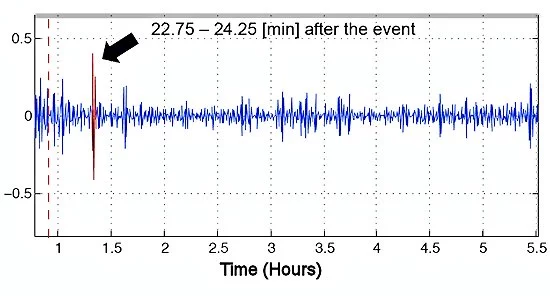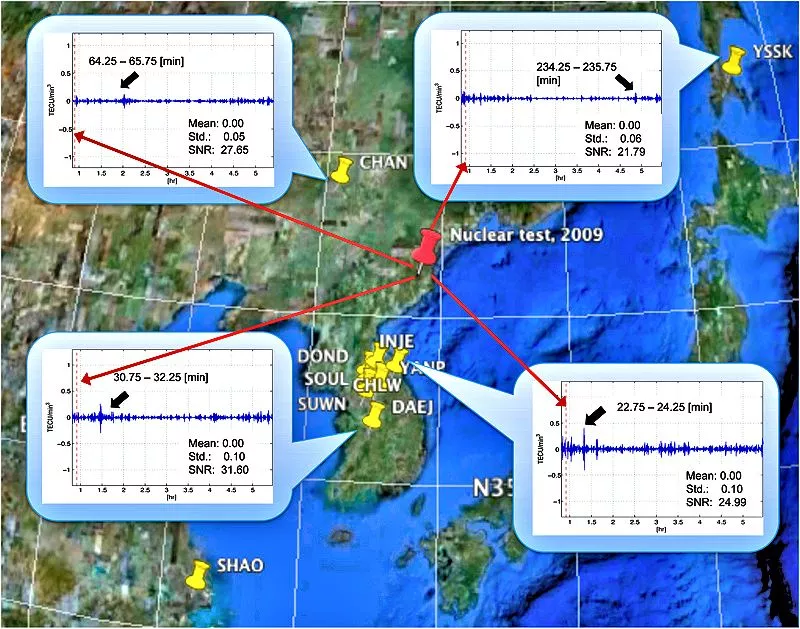Given that rogue nuclear tests are always conducted underground, the search for them has focused on efforts to refine the identification of characteristic seismic signatures. Now, researchers at Ohio State University (OSU) have discovered new detection methods in unlikely places – the rejected noise in GPS measurements and radio astronomy.
Currently, the best tool for detection of clandestine underground nuclear explosions (UNE), such as North Korea's (NK's) 2006 and 2009 tests, is the analysis of seismic signals. However, the interpretation of seismic data, particularly seismic data from low-yield explosions, is difficult. For example, the 2006 NK test was an apparent "fizzle," yielding well under a kiloton of explosive energy, and the seismic data alone was not sufficient to confidently identify the event as a UNE.
The Ground Positioning Satellite (GPS) system continuously measures the transmission time between the satellites and ground stations. Minor changes in transmission time routinely occur as the GPS signal passes through the Earth's ionosphere between 100-500 km (62-310 miles) in altitude. Because the GPS system finds a location by comparing the transit times between a user and a number of satellites, the system is continuously being corrected to oppose such changes. The process of determining the required corrections also effectively measures the total ionospheric electron density along the GPS signal path.

After the 2009 NK test, a group of GPS specialists from Ohio State University noticed something unexpected. A number of GPS stations surrounding the NK test site (located by interpreting seismic data) detected a short-lived disturbance in ionospheric electron density apparently associated with the Korean nuclear detonation. The time at which these changes were detected varied with the distance of the GPS ground station from the North Korean nuclear test site.

Nuclear weapons effects researchers discovered during the 1970s that buried nuclear explosions can generate detectable ionospheric disturbances, but how does that happen? A UNE generates a huge electromagnetic pulse that travels skyward into the ionosphere. When this pulse interacts with the electron plasma in the ionosphere, a traveling ionospheric disturbance (TID) is excited (more or less a charged sound wave), which moves roughly parallel to the Earth's surface.
Ionospheric researchers have also known since 1998 that TIDs can be seen in GPS signal data through the timing corrections required to allow the GPS system to accurately and reliably locate positions on the earth. However, it was not until the OSU group's recent work that these two neatly interlocking facts were assembled into a sophisticated method of detecting and locating underground nuclear tests.
Dr. Jihye Park and her collaborators, in what would become the core of her PhD thesis, studied the pattern of GPS delay signals observed immediately following the 2009 NK UNE test. Noting that the disturbance required more time to reach more distant GPS ground stations, the simplest explanation was that an ionospheric disturbance traveled outward from a single source at a constant velocity. Testing this hypothesis against the data, she found a common source for the TIDs that was consistent with that data. The common source was located fewer than four kilometers (2.5 miles) from the center of the seismic signals generated by the 2009 NK nuclear test.
The OSU group determined that the 2009 TID was traveling at a nominal altitude of about 300 km (186 miles) at a speed of about 870 km/h (540 mph). They also found a small TID associated with the 2006 NK UNE, which exhibited the same basic signature that they found for the more cleanly detected 2009 NK test. Dr. Park compared these UNE signatures with those generated by TIDs associated with the massive 2011 Japanese earthquake, and found completely different patterns, showing that analysis of GPS signals does not confuse earthquakes and UNEs.
Dr. Park's team has now studied GPS signal delays following two US UNE tests carried out in 1992, the 20-kiloton Hunters Trophy and Divider tests conducted at the Nevada Test Site. Using essentially the same analysis methods as they developed to study the 2009 NK UNE, they found traveling ionospheric disturbances with essentially the same waveform, but traveling at about three times the speed of the TID driven by the 2009 NK UNE.

The Very Large Array (VLA) radio telescope, located near Socorro, New Mexico, was also used to look for TIDs associated with the 1992 US underground tests. Because VLA measures correlations between signals from pairs of antennas to reconstruct images of the sky, it too is sensitive to and must be continuously corrected for time delays caused by ionospheric fluctuations. The OSU team, with the help of researchers at the VLA facility, found a TID signature associated with the Hunters Trophy UNE that strongly resembled that of the GPS signal.
Dr. Park and her collaborators have demonstrated a sensitive and robust new technique for detecting and locating underground nuclear tests. While this technique does seem to also provide additional information (e.g., the yield of the explosion), it will be very difficult to calibrate in an environment where the only signal sources are rogue nuclear tests.
As a result, it seems unlikely that the GPS and related ionospheric detection techniques will change the fundamental political forces now disrupting ratification of the comprehensive test ban treaty or serious disarmament programs. Despite this limitation, having a new arrow in the quiver of verification methods is quite welcome.
Source: Ohio State University





